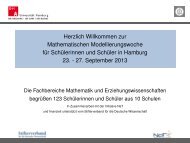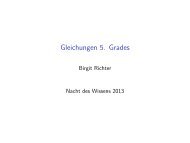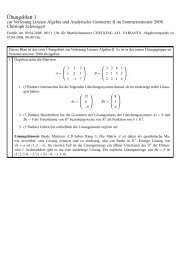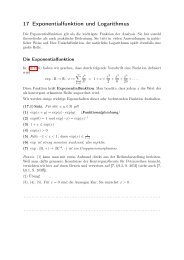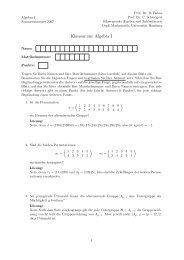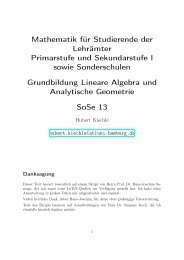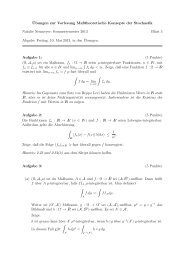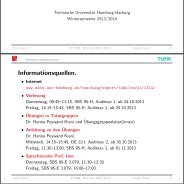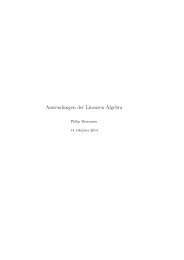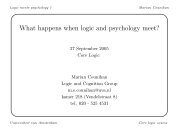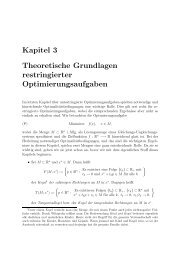pdf file
pdf file
pdf file
You also want an ePaper? Increase the reach of your titles
YUMPU automatically turns print PDFs into web optimized ePapers that Google loves.
Remark 2.4.8.<br />
Let (A, μ, Δ) again be a bialgebra. Then the category comod-A of right A-comodules is a<br />
tensor category as well. Given two comodules (M, Δ M ) and (N, Δ N ), the coaction on the tensor<br />
product M ⊗ N is defined using the multiplication:<br />
Δ M⊗N :<br />
M ⊗ N Δ M ⊗Δ<br />
−→<br />
N<br />
id<br />
M ⊗ A ⊗ N ⊗ A<br />
M ⊗τ⊗id<br />
−→<br />
A<br />
M ⊗ N ⊗ A ⊗ A<br />
id M⊗N ⊗μ<br />
−→ M ⊗ N ⊗ A .<br />
It is straightforward to dualize all statements we made earlier.<br />
In particular, the tensor unit is the trivial comodule which is the ground field K with a<br />
coaction that is given by the unit η : K → A:<br />
K<br />
η<br />
−→ A ∼ = K ⊗ A .<br />
Again, the associativity and unit constraints of comodules are inherited from the constraints<br />
for vector spaces:<br />
(M ⊗ N) ⊗ P ∼ = M ⊗ (N ⊗ P )<br />
K ⊗ M ∼ = M ∼ = M ⊗ K .<br />
2.5 Hopf algebras<br />
Observation 2.5.1.<br />
Let (A, μ) be a unital algebra and (C, Δ) a counital coalgebra over the same field K. We can<br />
then define on the K-vector space of linear maps Hom(C, A) a product, called convolution. For<br />
f, g ∈ Hom(C, A) this is the morphism<br />
f ∗ g : C<br />
−→ Δ<br />
C ⊗ C −→ f⊗g<br />
A ⊗ A −→ μ<br />
A .<br />
This product is K-bilinear and associative. In Sweedler notation<br />
(f ∗ g)(x) = f(x (1) ) ∙ g(x (2) ) .<br />
The linear map<br />
C<br />
−→ ɛ<br />
K −→ η<br />
A<br />
is a unit for this product.<br />
This endows in particular the space End K (A) of endomorphisms of a bialgebra A with the<br />
structure of a unital associative K-algebra. It is, however, not clear whether in this case the<br />
identity id A ∈ End K (A) is an invertible element of the convolution algebra.<br />
Definition 2.5.2<br />
We say that a bialgebra (H, μ, Δ) is a Hopf algebra, if, under the convolution product, the<br />
identity id H has a two-sided inverse S : H → H, called the antipode.<br />
Remarks 2.5.3.<br />
1. The defining identity of the antipode<br />
S ∗ id H = id H ∗ S = ηɛ<br />
reads in graphical notation<br />
31




